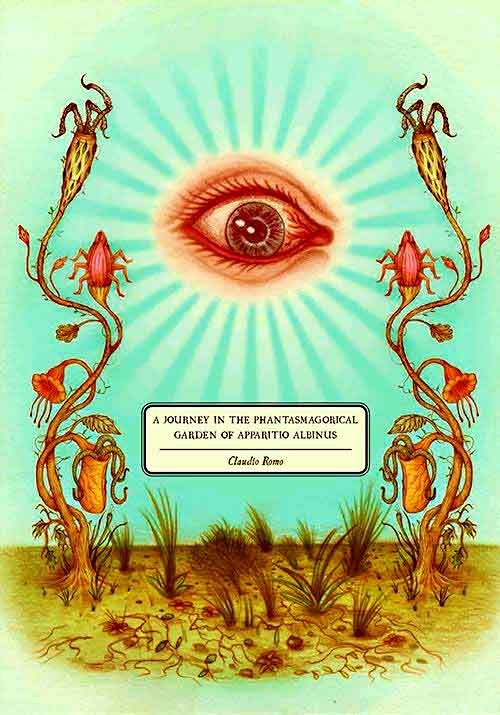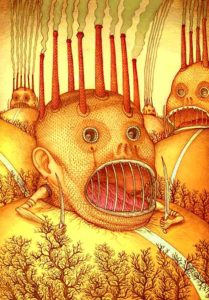 By CLAUDIO ROMO (Gingko Press; 2016/17)
By CLAUDIO ROMO (Gingko Press; 2016/17)
In the category of Raymond Roussel/H.P. Lovecraft/Clark Ashton Smith/Jorge Luis Borges inspired oddities this quasi-graphic novel, originally published in Italy back in 2016, definitely stands out. A JOURNEY IN THE PHANTASMAGORICAL GARDEN OF APPARITIA ALBINUS‘s overall conception is inspired by Roussel’s LOCUS SOLUS, being, simply, an account of a vast garden “filled with ghosts”—creatures, actually, each of which is given a name, paragraph-long backstory and full-page illustration.
…this quasi-graphic novel, originally published in Italy back in 2016, definitely stands out.
Among the critters residing in Apparitio Albinus’s garden are “Flavia, the Gynoid Scribe,” a prehistoric female automaton who spends her days transcribing her voluminous history; “Mimoids” created by a sentient ocean that take the form of “huge skeletons of primordial beings whose continuous kaleidoscopic metamorphoses represent—as though on the stage of a theater—something which we can only guess at”; “Fishassassins” employed by aquatic Tritons to, among other things, incubate their eggs; a picture taking “Phantasmagorical Machine” that literally absorbs the souls of the people it photographs; and “The Cosmonauts,” a race of extraterrestrial beings who periodically fly their spaceships over the garden.
The illustrations, accomplished by the book’s author Claudio Romo, are impressively drafted with an eye of biologic surrealism.
 The illustrations, accomplished by the book’s author Claudio Romo, are impressively drafted with an eye of biologic surrealism. Insectoid and fish-like creatures predominate, with a wealth of detail that does justice to Romo’s insanely ornate descriptions (ex: “The sky also contains immense nebulae gravid with cosmic dust and primordial soma, generators of untold worlds, constructors, demiurges of infinitely faraway realities and times”). Credit must also go to translator David Haughton, who’s up to the challenge of rendering Romo’s adjective-heavy verbiage in English.
The illustrations, accomplished by the book’s author Claudio Romo, are impressively drafted with an eye of biologic surrealism. Insectoid and fish-like creatures predominate, with a wealth of detail that does justice to Romo’s insanely ornate descriptions (ex: “The sky also contains immense nebulae gravid with cosmic dust and primordial soma, generators of untold worlds, constructors, demiurges of infinitely faraway realities and times”). Credit must also go to translator David Haughton, who’s up to the challenge of rendering Romo’s adjective-heavy verbiage in English.
A brief memoir at the end of the book fleshes out the obsessions of its author/illustrator,
A brief memoir at the end of the book fleshes out the obsessions of its author/illustrator, which stem, Romo claims, from the religious iconography and other ephemera he encountered during his childhood. Those influences are all quite evident here, with the work of the above-mentioned likes of Roussel, Lovecraft, Smith and Borges colliding with that of Salvador Dali, FANTASTIC PLANET, DUNE and FLASH GORDON. That would explain why this “Phantasmagorical Journey” often feels more like a confluence of influences—or homages—than a proper book. Overall, though, it has a beauty and strangeness that are unique to itself, and the mind of a creator who admittedly “takes pleasure in publishing the kind of books that I would have always loved to hold in my hands.”
